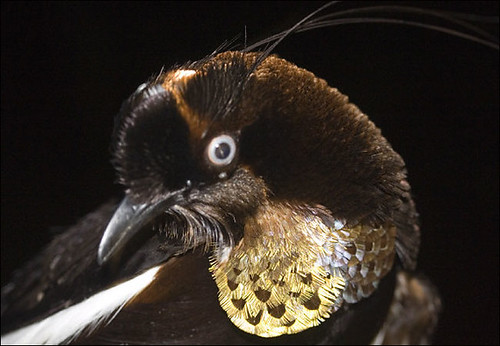
Male Berlepsch's Six-wired Bird of Paradise, Parotia berlepschi.
Photo by Bruce Beehler.
Click image for larger version in its own window.
I would give anything -- in fact, I'd give absolutely everything I ever had, currently have and could ever hope to have -- to be part of the recent
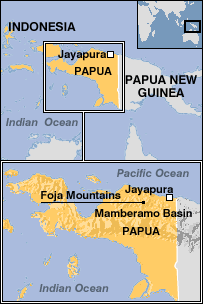 Beehler gathered a team of 25 international scientists to conduct the first ever survey of biological diversity in this pristine region of tropical rainforest and they discovered many species that are new to science, along with several formerly "lost" species, including the Golden-fronted Bowerbird, Amblyornis flavifrons, and Berlepsch's Six-wired Bird of Paradise, Parotia berlepschi (pictured, top). The mysterious bird of paradise was formally described in 1897 by the German ornithologist, Otto Kleinschmidt, from study skins prepared from dead birds found in the private museum of Hans von Berlepsch.
Beehler gathered a team of 25 international scientists to conduct the first ever survey of biological diversity in this pristine region of tropical rainforest and they discovered many species that are new to science, along with several formerly "lost" species, including the Golden-fronted Bowerbird, Amblyornis flavifrons, and Berlepsch's Six-wired Bird of Paradise, Parotia berlepschi (pictured, top). The mysterious bird of paradise was formally described in 1897 by the German ornithologist, Otto Kleinschmidt, from study skins prepared from dead birds found in the private museum of Hans von Berlepsch.
"This mystery bird was, in essence, forgotten by the ornithological world in a way that the Golden-fronted Bowerbird was not," says Beehler. "That's the difference in impact of a 'species' versus a 'subspecies.'"
The researchers spent nearly a month in the area, collecting flora and fauna from the lower hills up to nearly the summit of the Foja Range, which reaches approximately 2,200 meters in elevation. They were only able to explore a very small portion of the area, which covers approximately 300,000 hectares. The region lies on the upper slopes of the Foja Mountains, in the easternmost and least explored province of western New Guinea, which is part of Indonesia. The rugged mountainous terrain has allowed hundreds of distinct species to evolve, often specific to small areas, which makes New Guinea the most biodiverse place on earth.
"It's beautiful, untouched, unpopulated forest; there's no evidence of human impact or presence up in these mountains," said Beehler.
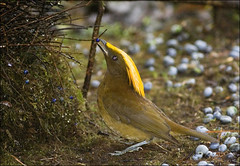 The only other scientist to ever explore the Foja Mountains was University of California ornithologist and geographer, Jared Diamond. Among Diamond's discoveries in 1979 and 1981 were the formerly "lost" Golden-fronted Bowerbird (pictured, right. Click image for larger view), and the female bird of paradise. However, Diamond did not see the distinctive male described in Kleinschmidt's notes.
The only other scientist to ever explore the Foja Mountains was University of California ornithologist and geographer, Jared Diamond. Among Diamond's discoveries in 1979 and 1981 were the formerly "lost" Golden-fronted Bowerbird (pictured, right. Click image for larger view), and the female bird of paradise. However, Diamond did not see the distinctive male described in Kleinschmidt's notes.
"This is a place with no roads or trails and never, so far as we know, visited by man," said Beehler. "This proves there are still places to be discovered that man has not touched."
According to Beehler, even two local indigenous groups, the Kwerba and Papasena people, customary landowners of the forest who accompanied the scientists, were astonished at the area's isolation.
"We were dropped in by helicopter. There's not a trail anywhere; it was really hard to get around."
On only the second day of the team's expedition, the amazed scientists watched as a male Berlepsch's bird of paradise performed a courtship dance for an attending female in their field camp. This was the first time a live male of the species had been observed by Western scientists, and it proved that the Foja Mountains was the species' home.
The Foja Range is incredibly rich in bird life: more than 225 species breed in the area, including 13 species of birds of paradise. One scientist in the party exclaimed that the avian "dawn chorus" was the most fantastic he had ever heard.
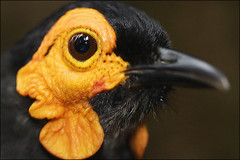 Beehler's group captured the first photographs of the live bird of paradise and of the Golden-fronted Bowerbird. Additionally, within mere hours of arrival, the team discovered a new species of Smoky Honeyeater (pictured, left. Click image for larger view) -- the first new species of bird to be described for New Guinea in more than 60 years.
Beehler's group captured the first photographs of the live bird of paradise and of the Golden-fronted Bowerbird. Additionally, within mere hours of arrival, the team discovered a new species of Smoky Honeyeater (pictured, left. Click image for larger view) -- the first new species of bird to be described for New Guinea in more than 60 years.
"This [Bird of Paradise] had been filed away and forgotten; it had been lost. To rediscover it was, for me, in some ways, more exciting than finding the honeyeater. I spent 20 years working on birds of paradise; they're pretty darn sexy beasts," said Beehler.
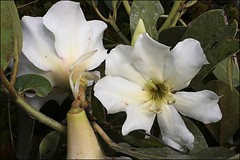 The team found more than 60 species of frogs, including 20 that were previously unknown to science, and one of which is less than 14 millimeters (half an inch) long; they identified more than 150 species of butterflies, and discovered four new butterfly species; they found 40 species of mammals and described a new large mammal for Indonesia: the Golden-mantled Tree Kangaroo, Dendrolagus pulcherrimus, which was not known to live on New Guinea. The scientists also identified at least 550 species of plants, describing five new palms and an epiphytic rhododendron that bears the largest flower ever seen for this genus -- almost six inches across (pictured, right. Click image for larger view).
The team found more than 60 species of frogs, including 20 that were previously unknown to science, and one of which is less than 14 millimeters (half an inch) long; they identified more than 150 species of butterflies, and discovered four new butterfly species; they found 40 species of mammals and described a new large mammal for Indonesia: the Golden-mantled Tree Kangaroo, Dendrolagus pulcherrimus, which was not known to live on New Guinea. The scientists also identified at least 550 species of plants, describing five new palms and an epiphytic rhododendron that bears the largest flower ever seen for this genus -- almost six inches across (pictured, right. Click image for larger view).
"What was amazing was the lack of wariness of all the animals. In the wild, all species tend to be shy of humans, but that is learnt behaviour because they have encountered mankind. In Foja they did not appear to mind our presence at all," Beehler remarked.
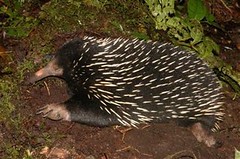 Two long-beaked echidnas, Zaglossus bruijni (pictured, left. Click image for larger view), a primitive egg-laying mammal that is classified as a monotreme, even allowed scientists to pick them up and bring them back to their camp to be studied, he added.
Two long-beaked echidnas, Zaglossus bruijni (pictured, left. Click image for larger view), a primitive egg-laying mammal that is classified as a monotreme, even allowed scientists to pick them up and bring them back to their camp to be studied, he added.
"Yet we've just scratched the surface," says Beehler, who is already planning a follow-up trip to the range in late 2006. "The Foja Mountains are a key part of the Mamberamo conservation corridor, CI's largest terrestrial priority in Melanesia. With the new scientific information from this expedition, we hope to refine our conservation plan for the area and generate more political support for conservation in the region."
This expedition was organized by Conservation International, based in the United States, and the Indonesian Institute of Sciences (Indonesian language only).
Please, oh please, take me with you.
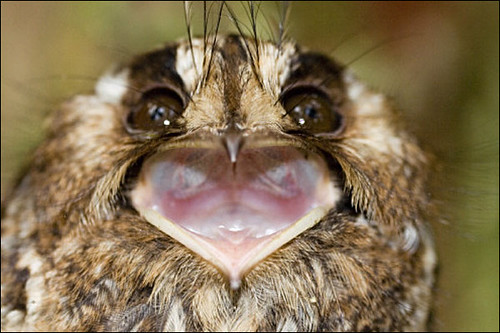
Mountain Owlet-Nightjar, Aegotheles albertisi .
Photo by Bruce Beehler.
Click image for larger version in its own window.
Sources:
BBC News story, including streaming video.
Associated Press News story, including a slideshow.
The Independent news story and analysis.
Radio Expeditions, National Public Radio (both text and streaming audio)
Included with the best science, nature and medical blog writing by
the Tangled Bank Blog Carnival,
Issue 47.
Included in the Blog Carnival, I and the Bird, Issue #17,
the Best of Bird-related Blog Writing.
Nominated (!!) to the Big Apple Blog Festival
Issue 25.
Also chosen as the Host's Top Pick
by the Carnival of the Vanities,
Issue 178.


I was wondering how long it would take you to post on this!
Damn it. Another new bird? That makes 8,994 extant species I still have to draw or paint. Stop this; stop it right now!
After looking around at all those reports I had to come here to see what you say and - your account is the clearest and best written of them all.
I was fooling around before of course, but Bora (coturnix) is right! Of all the accounts I've read, your piece is put together the best, both in writing and order of quotes. They really should take you Hegwig!
"Two long-beaked echidnas ... a primitive egg-laying mammal that is classified as a marsupial"
Is it? I thought it was a monotreme. Are monotremes marsupials? I thought that mammals were subdivided into placentals, marsupials and monotremes (or prototheria)...
Carl; given that there are not enough birds on the earth, and that people have already caused the extinction of more than enough species, i am thrilled to learn there are a few more out there that share the planet with us. i hope that we, as a species, play nice. and thanks for your kind words.
oh, don't forget that my research could very likely add a species or two to your bird list, too.
Coturnix; thanks! you are so sweet to me.
Pough; you are right, of course. um, that was a brain fart.
I agree with all the others in that your writeup is the best, but how come no photos or mention of the cassowaries? Those things are cool. Not to mention dangerous! Boy, did those handlers get nervous when I got closer to take photos at the Parrot Jungle in Miami...
photo gallery
Fantastic report on what are great news, you're still the best at giving bird news. I particularly enjoy your bird bias, the only non-feathered animal you show is nonetheless beaked and egg-laying. The thing that really stuck to my mind was:
"within mere hours of arrival, the team discovered a new species of Smoky Honeyeater"
I understand why you wish you were there. It's a good think this came out so far from friday, all other birds in the news would pale compared to this (even the dog-chasing giant owl in the UK).
Gosh... I can only imagine the thrill of coming across 'lost' species! And such beautiful creatures....
I agree with the concensus; your write up of this story is the best I've seen. Thanks. The press releases have been kind of hyperbolic. The Foja Mts. have been explored by a number of other biologists. The kangaroo Dendrolagus (goodfellowi) pulcherimus was discovered on New Guinea in the '80s, and described by Tim Flannery in '93. He listed its known range as "the Toricelli and Foja Mts." The Golden-fronted Bowerbird (Amblyornis flavifrons), known only from the Fojas, I believe, is listed as a common bird there.
Okay, when they take you along do you have room to bring me? I could cook or carry bags or or or... please.
Fantastic photos
pough; Beehler et al., never mentioned cassowaries in any of their accounts. perhaps they didn't see them on this trip? they barely left the trail that they cut through the brush, and the trail was short, so the lack of cassowary interactions is not surprising.
Caio de Gaia; thanks for your kind words. i am glad that you liked the story.
Trix; hey, it's good to see you here, and i am pleased to know that you read and enjoyed this story in particular.
Carel; the Foja Mountains cover a large area, so there is plenty of room to explore areas that have never been seen before!
Clare; the photos wereall taken by members of the expedition. the bird photos were all taken by Bruce Beehler.
So why no pix of the Leps? Five new species of butterflies makes me salivate. I'd bet my bottom dollar at least one of these critters is an Ornithoptera. . . .
Prince; they found four (not five) new species of butterflies .. anyway, my Lepidoptera taxonomy is rusty, but if i recall correctly, one of the new butterfly species has a huge wingspan .. 6 or 7 inches? if so, my edumacated guess is this particular species could be another Ornithoptera. i will try to get photos of the butterflies and will publish them on my blog when/if i do.
Hedwig,
Below is the URL where you post your CV, resume, letters of recommendations, and pleas to go birding in remote indonesian provinces with the CI teams.
http://www.conservation.org/xp/CIWEB/about/jobs/jobapp.xml
Go for it!
Irian Jaya was a much cooler name.
I am looking for Dr. Bruce Beehler's CV or short Bio on line.
Please send to the following address
dfo@date.cnet.pg or dorcherton@fo.unitech.net.pg